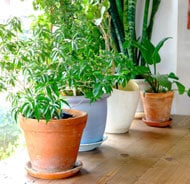Since most houseplants are tropical in origin, they are not tolerant of freezing temperatures and should be kept inside during the winter. Keeping them healthy and attractive is dependent on light levels and moisture.
Each type of houseplant has certain specific cultural requirements for optimal growth. Some plants, especially succulent one such as aloes and cacti, require significantly less water than peace lilies and African violets. Ferns prefer lower light levels, but wax begonias need higher levels.
Plants that develop spindly new growth and leaves that are spaced far apart are not receiving adequate light. Using artificial plant lights will help, but may not provide the necessary amount of light needed for optimal growth. The lights should only be used to supplement sunlight. Most plants should be placed near south or west facing windows where they can receive adequate light levels. If the plants develop a long, leggy growth pattern, then they are not receiving adequate light levels. Move them to another place where they can get sufficient light.
In winter, fertilization levels should be reduced by one-half as the growth of the plants slows as a result of the cooler temperatures and lower light levels. Use liquid fertilizers because the diluted solution reduces the likelihood of fertilizer burn.
The house plants require more water during the winter months due to indoor heating systems that reduce humidity and dry out the plants. To determine if the plants should be watered, stick your finger in the soil to a depth of at least one inch, and if dry, then it needs water. Apply water until it trickles out of the bottom of the pot. Be sure to drain the water from the saucer under the pot. Group the plants together in the same area, and place the pots in shallow trays filled with gravel and water to help maintain the humidity. Avoid using water that is either too hot or too cold. The temperature of the water should be between 65 and 75 °F.
A few of pests occasionally trouble houseplants. The most common are mealybugs and aphids. Mealybugs appear as a cottony mass on the leaves and stems. Aphids appear as small insects roughly one-eighth of an inch in length and secrete a sticky honeydew substance. They can be controlled by washing using water to remove them by applying insecticidal soaps, which smother the insects.
Using a damp cloth, you should clean dust accumulations from the leaves that can dull their appearance and reduce their attractiveness. In the following spring, examine the plants to see if they need to be re-potted. Remove the dead parts and the excessive growth, water thoroughly and place them outside after all danger of frost has passed.
Timothy Daly, is an Agricultural and Natural Resource Extension Agent with Gwinnett County. He can be contacted at 678-377-4010 or tdaly@uga.edu


